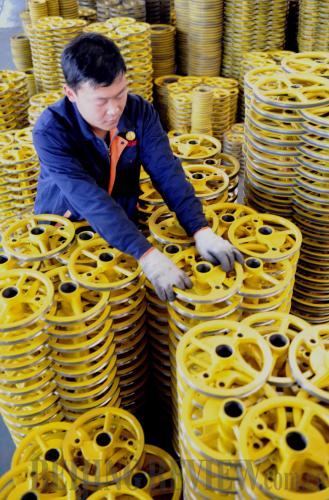|
 |
|
EYEING HIGH-END PRODUCTION: A worker sorts out elevator components in Yongqing County, north China's Hebei Province (LI XIAOGUO) |
Trading Band Widened
China's central bank widened the yuan's daily trading band from the current 1 percent to 2 percent on March 17.
Chinese banks now can exchange the yuan in the foreign exchange spot market at 2 percent above or below the central parity against the U.S. dollar announced by the China Foreign Exchange Trading System each trading day, according to the statement from the People's Bank of China (PBC).
The move will enhance the floating flexibility of the yuan exchange rate and improve the efficiency of capital allocation, facilitate economic restructuring and beef up the decisive role of the market in allocating resources, the PBC said.
China has taken a gradual and steady pace in raising its currency's daily trading limit, from 0.3 percent in 1994 to 0.5 percent in 2007 and 1 percent in 2012 to the most recent 2 percent.
The Chinese yuan experienced continued weakening against the U.S. dollar in February, causing widespread concerns over its domestic and international impacts on trade and the financial sector. The widening of the trading band will not lead to steep depreciation of the Chinese yuan, the central bank said, citing the improving balance of payments and rich foreign exchange deposit.
The PBC will further push the liberalization of the yuan's exchange rate and diversify foreign exchange products to build a market-guided and properly regulated floating exchange rate system.
Growth Moderated
Home prices in major Chinese cities grew at a slower pace in February, with fewer cities seeing month-on-month price rises, official data showed on March 18.
In February, new home prices in 70 major cities tracked by the National Bureau of Statistics (NBS) rose by an average of 11.1 percent year on year, slowing by 1.3 percentage points from January, the NBS said in a statement.
Prices for existing homes rose 6.4 percent year on year, compared with an average growth of 7.4 percent in January, according to the statement.
Month on month, 57 out of the statistical pool of 70 cities saw rises in new home prices, fewer than the 62 cities that experienced the same phenomenon in January. Prices dropped in four cities and stayed unchanged from a month ago in the other nine cities.
For existing homes, prices increased in 46 cities month on month, down from 48 cities in the previous month. Prices dropped in 15 cities and remained flat in nine cities, the NBS said.
"The deceleration in home price growth was partly due to tapering pent-up demand after rapid home sales growth in 2013," said Lu Ting, chief China economist with Bank of America Merrill Lynch.
Moreover, tight mortgage conditions and higher second-home mortgage down payments in many major cities could also have weakened property demand, Lu said.
Cutting Red Tape
China's banking regulator said on March 19 that it will simplify administrative procedures for establishing rural commercial banks and credit cooperatives.
The China Banking Regulatory Commission (CBRC) said the procedures to be scrapped, totaling 13, include approvals over appointment of senior management, banks' fund custodian services, and stock collateral loan business under new regulations.
The new rules aim to simplify the conditions for setting up rural commercial banks and credit cooperatives as well as making it easier for all kinds of capital to be included in building the rural financial system.
However, the regulator said the banks' performance, including their strategic development and company management, will be supervised after they are established.
The total assets of small and medium-sized financial institutions in rural China stood at 19.45 trillion yuan ($3.17 trillion) as of the end of January, accounting for 13.1 percent of the banking sector's total in the country.
| 